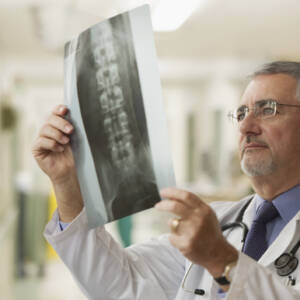What information does a bone density measurement provide?
A properly conducted bone density test provides important data on the resistance of your bone to fracture, if subjected to ‘excessive force’ often in a fall.
However, because the excessive force is also important in the development of a fracture, information on your chances of falling is also important. As we age our bone structure deteriorates and we are less stable and fall more. This double whammy is why osteoporosis predisposing to fracture matters and explains why high-quality bone density is so important in predicting a high risk of fracture that can be reduced by lifestyle and pharmaceutical therapies.
People at special risk
There are some who, because of increased genetic risk or particular diseases, have reduced bone structure. Arthritis and Osteoporosis WA is planning support to a paediatric colleague of mine, who will be starting a PhD studying genetic disorders of bone disease (in both children and adults) to better understand how to reduce fractures. Bone density to assess bone strength will be a major part of these studies.
Why high-quality bone density testing is important
Bone density services are often provided by radiology practices. Unfortunately, some practices no longer supply the pictures of the bone density test to you, to allow you and your doctor to understand if the test has been undertaken correctly.
In the past, if you had an x-ray you would be given the films for you and your doctor to understand what has been done, and in conjunction with the report, allow understanding of what would be the best treatment. Often the image quality is so poor it is difficult to determine if the correct part of the skeleton has been assessed.
This matters because the strength of your bones is determined by reference to what has happened to others with similar results. If the wrong part of your skeleton has been measured, the reference range from other people cannot be used and the test is of no value.
An important part of bone density testing is whether your risk is increasing or decreasing. In this regard, the reproducibility of the test is important, as we need to be sure whether the same part of your skeleton was measured in the same way, so a valid comparison can be made. Without the pictures, we cannot be sure.
An important part of bone density testing is to interpret the data in terms of the risk of fracture in percentage terms for you over the next 5 to 10 years. This allows you to decide how worried you should be over your fracture risk and what needs to be done to reduce that risk.
Another problem is that many reports do not show your results as a graph over time in comparison to the reference range. Being able to see this on easily readable graphs makes it much easier for you, the patient, to know whether the bone strength is better, the same or worse and is the basis of predicting your risk of fracture.
How to ensure high-quality bone density testing
Bone density testing and its interpretation are quite complicated. To ensure you are receiving a high-quality service, always ask the service measuring your bone density for a copy of the report and the pictures. This will allow you and your doctor to be confident of the quality of the service you have paid for, and improve your understanding of the advice you receive from your treating doctor to improve your understanding of what is required.
By Prof Richard Prince BSc, MB ChB Birm, MD Melb, FRACP, MRCP (UK)





